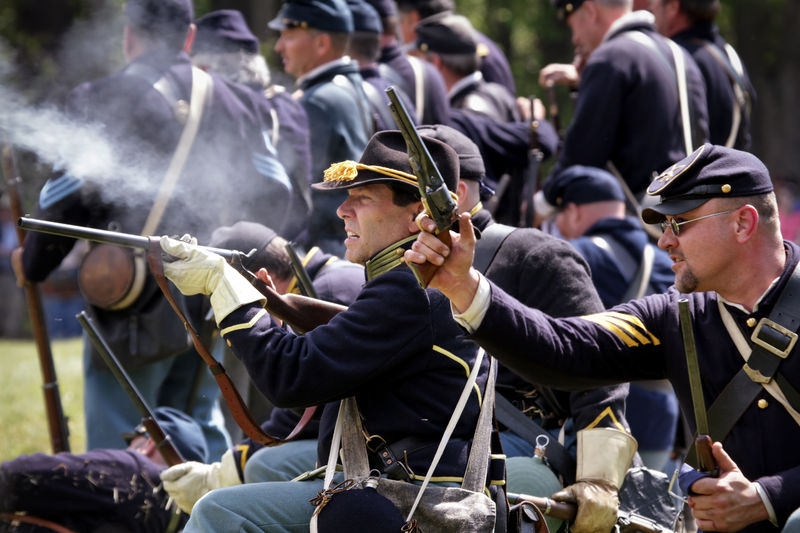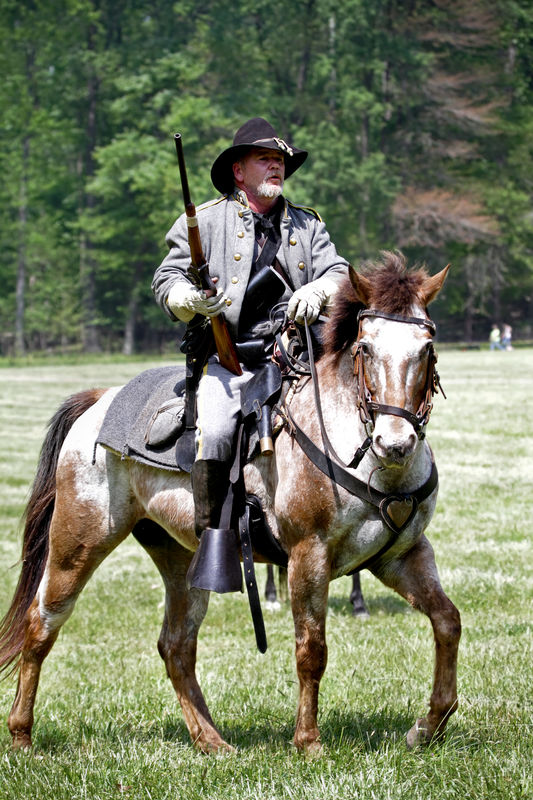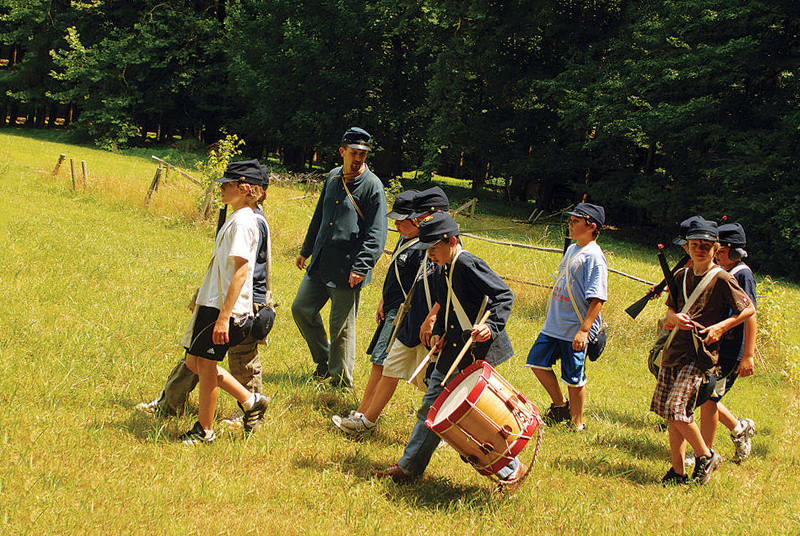Historical Reflections: A Civil War Guide to Newport News
Historical Reflections: A Civil War Guide to Newport News, VA

photos courtesy of the Newport News Tourism Development Office
More than 150 years ago, the woods and waters of Newport News, Virginia, echoed with the sounds of the Civil War: the tramp of thousands of boots along the Great Warwick Road, the thunder of cannon and the crack of rifle fire, the shout of orders and the cries of the wounded and the dying. The Civil War in Newport News witnessed the world’s first battle between ironclad warships and the awarding of two Medals of Honor. African Americans also experienced a growing role in the U.S. Armed Forces. Local women such as Maria Whitaker Curtis of Endview Plantation and Martha Lee of Lee Hall Mansion found new challenges as they worked on the home front.
Today, Newport News pays tribute to the heroes of the past with historic homes, battle sites, fortifications, monuments and extraordinary collections of personal artifacts. The story of the Civil War is the story of the people – men and women, black and white, slave and free, rich and poor, decorated generals and common soldiers.
Begin your tour at Fort Monroe, the largest stone fort ever built in the United States. A shelter for escaped slaves beginning in 1861, many famous people have also walked the grounds at this historic moat-encircled fort, including Robert E. Lee as a young officer, Jefferson Davis as a Union prisoner and Harriet Tubman as a Civil War nurse.
As you continue your tour of the Civil War in Newport News, the stories of the participants are told at each site along the way. Learn about Union sailors aboard the USS Monitor at The Mariners’ Museum, where you can walk the deck of a full-scale replica of this iconic ship. Meet a figure from the past when you attend one of our Civil War living history programs at the James A. Fields House, Endview Plantation, Lee Hall Mansion or The Mariners’ Museum/USS MonitorCenter. Trace the role of African Americans in the U.S. Armed Forces at the Virginia War Museum and the James A. Fields House. Memorials to Confederate and Union soldiers and sailors, uniforms, weapons, photographs and letters are all awaiting your discovery.
Our story begins only weeks after the first shots of the Civil War were fired at Fort Sumter. In May 1861, three slaves who had been laboring on Confederate fortifications escaped to Fort Monroe. Their owner angrily demanded their return. Union Major General Benjamin F. Butler refused, saying that the slaves were “contraband of war.” Butler wrote: “I replied that the Fugitive Slave Act did not affect a foreign country, which Virginia claimed to be.” By late spring, more than 1,000 escaped slaves were sheltered at Fort Monroe. In August, Congress officially endorsed Butler’s stand, passing the cautiously worded Confiscation Act. Despite this act, Confederate forces on the Peninsula continued using African-American labor in the construction of their defensive fortifications from the summer of 1861 to the spring of 1862. In early spring 1862, all eyes turned to the Virginia Peninsula and Hampton Roads.
1862 Peninsula Campaign Sites in Newport News, VA
Congress and Cumberland Overlook
Deep beneath the James River lie the remains of the 24-gun USS Cumberland, the first wooden ship to fall victim to the powerful Confederate ironclad ram Virginia. The Confederates had converted the CSS Virginia from the former steam frigate, the USS Merrimack, by cutting the hull down to the waterline and then covering it with 4 inches of iron plate on top of 22 inches of oak and pine. Armed with 10 guns, she was also fitted with a 6-foot long, 1,500-pound cast-iron ram.
On March 8, 1862, the Virginia, appearing like a “floating barn belching smoke,” emerged from the Elizabeth River to challenge both the Cumberland and its sister vessel, the 50-gun USS Congress. The Cumberland was rammed and sank with the loss of 121 men. Next, the Virginia shelled the Congress into submission and reduced it to a blazing hulk that later exploded. The powerful Union wooden fleet was no match for the Confederate ironclad. According to a telegram from a newspaperman who witnessed the encounters, the Union cannon shot had no effect on the Virginia, “but glanced off like pebble stones.”
MONITOR-MERRIMACK OVERLOOK
As the burning Congress cast an eerie glow across the waters of the harbor, the USS Monitor arrived in Hampton Roads. A completely new concept in naval design by Swedish-born inventor John Ericsson, the Monitor featured a steam-powered rotating circular turret mounted with two 11-inch Dahlgren cannons. There were 8 inches of iron plate on the turret and 4-1/2 inches of armor plate covered the deck.
In the morning light of March 9, 1862, the Monitor approached the Virginia. For four hours, the ironclads dueled each other with neither ship able to inflict a deathblow on the other. “I often thought of you and the little darlings when the fight was going on and what should become of you should I be killed,” wrote Union sailor George Geer to his wife, Martha, “but I should have no more such fears as our ship resisted everything they could fire at her as though they were spit balls.” The two ironclads never fought again – the Virginia was destroyed by its crew on May 11, 1862, when its home port fell into Union hands, and the Monitor sank in the waters off Cape Hatteras on December 31, 1862 – but their imprint on history was assured. Modern naval warfare was forever changed.
Following these two historic naval battles off Newport News, the focus shifted to Union Major General George B. McClellan’s planned advance to Richmond. General McClellan wanted to outflank the strong Confederate defenses in Northern Virginia and move his 121,500-man Army of the Potomac to Fort Monroe. His plan called for a rapid advance up the Peninsula to capture Richmond before the Confederates in Northern Virginia could save their capital. In his path stood Confederate Major General John B. Magruder’s three lines of fortifications that stretched across the Peninsula.
Causey’s Mill
On April 4, 1862, General McClellan dispatched Brigadier General Erasmus Keyes's IV Corps up the Great Warwick Road (present-day Warwick Boulevard) from Newport News Point past this location on the way to Young's Mill. Keyes's mission was to outflank the Confederate garrison in Yorktown and block their retreat to Williamsburg. Lead elements of the IV Corps skirmished with Confederate pickets on the site of what is now Causey’s Mill.
Completed in 1866, Causey's Mill is the only gristmill left on the Lower Peninsula with its original machinery. As a reminder of Newport News’ agrarian past, the mill is listed on the National Register of Historic Places. The Founders’ Trail marker on this site details the early history of the surrounding Waters Creek area. Also on this site are the Abernathy Gardens, which feature a labyrinth and unique plantings.
Young's Mill
The earthworks located on the high ground above Young’s Mill formed the Deep Creek anchor of Magruder’s first defensive line across the Peninsula. For almost one year, the Confederates had camped near Young's Mill and fortified this strategic position overlooking the Great Warwick Road. On their march toward the Warwick County Court House, Brigadier General William "Baldy" Smith's division of the IV Corps briefly engaged Confederate troops who abandoned this position on April 4, 1862. Afterwards, Union Private Wilbur Fisk wrote, “The rebels left quite a village of huts or barracks, and from appearances, they had enjoyed much more comfortable quarters during the winter than we had ourselves.” The Founders’ Trail marker on this site details the history of what was probably the first mill in the area.
Warwick County Court House
After encamping at Young's Mill, General Smith's Division on April 5, 1862, continued leading the IV Corps' advance. The Federals reached the Warwick County Court House later that afternoon. The court house, built in 1810, was looted and its grounds renamed Camp Winfield Scott. During the subsequent siege of the Confederate Warwick-Yorktown Line, General Keyes used the building as his headquarters. The Warwick County Court House area was later used as a launching site for the Union observation balloon Constitution.

Battle of Lee’s Mill
On the afternoon of April 5, 1862, Union forces marched from the Warwick County Court House toward Lee's Mill, where the Great Warwick Road crossed the Warwick River. The Federals were unaware of the Warwick River's true course, as they had inaccurate maps. At Lee's Mill, there were 1,800 Confederate troops and massive earthen field fortifications. “Baldy” Smith reported that as his men approached the Warwick River, “flames appeared on all sides” and he halted the advance. The flooded Warwick River and the Confederate Warwick-Yorktown defensive line halted McClellan's flanking maneuver to surround Magruder at Yorktown. Located on a 40-foot bluff overlooking the Warwick River, Lee's Mill Park preserves a strategic section of the Warwick-Yorktown Line and is listed on the National Register of Historic Places.
Battle of Dam No. 1
Following the Battle of Lee’s Mill, McClellan abandoned his plans for a rapid advance on Richmond and concentrated his forces on besieging the Confederate Warwick-Yorktown Line. From April 5 through May 3, 1862, both armies then built or strengthened their fortifications along the Warwick River. McClellan concentrated his siege engineering on Yorktown, planning 15 batteries for his heavy artillery. In a bold move, General Magruder maneuvered elements of his 13,000-man Army of the Peninsula along the Warwick River and tricked the Federals into over-estimating his troop strength. Private Edmund Dewitt Patterson of the 4th Alabama wrote that he and his fellow Confederate soldiers “have been traveling most of the day ... with no other view than to show ourselves to the enemy, at as many different points of the line as possible.”
“It was a wonderful thing,” wrote Mary Chestnut, the Charleston, S.C., diarist, “how [Magruder] played his ten thousand before McClellan like fireflies and utterly deluded him ….”
Magruder’s ploy, however, did not convince all of the Union commanders. "Baldy" Smith perceived that they outnumbered the Confederates, and he convinced McClellan to test the Confederate line at Dam No. 1. The Confederates had constructed three earthen dams on the Warwick beyond the prewar tidal mill dams at Lee’s Mill and Wynne’s Mill. Thus, they had created a formidable water barrier. On April 16, 1862, Union artillery shelled the Confederates at Dam No. 1, and Smith sent four companies of the 3rd Vermont Infantry across the river. Despite the heroism of the Green Mountain Boys, who remembered the battle site as “a creek with a wide dam which drank the blood of many of our men in one brief hour,” they were repulsed by swift Confederate counterattacks. McClellan and Smith had not reinforced the 3rd Vermont when they had broken through Magruder’s defenses. Captain Samuel Pingree and Private Julian Scott of the 3rd Vermont were later awarded the Medal of Honor for their gallantry on this day.
The lines along the Warwick River remained active with rifle and cannon fire until early May. In mid-April, Confederate General Joseph Johnston had arrived with his army and took command on the Peninsula. The new Confederate commander was not impressed with Magruder's fortifications and feared the coming Union artillery barrage. He decided to abandon the Warwick-Yorktown Line and retreat to Richmond. On the night of May 3, 1862, the Confederates unleashed a tremendous bombardment to cover their retreat. Magruder’s defensive lines had halted the Union march on Richmond for four critical weeks, ending McClellan’s plans for a swift capture of the Confederate capitol. As McClellan’s army began to pursue the retreating Confederates, some of them crossed at this location.
Generations later, ten miles of Magruder’s original fortifications remain in Newport News Park, the vast majority in an excellent state of preservation. Wooded nature trails feature historical markers, and the original Dam No. 1 site is visible beneath the waters of Lee Hall Reservoir. On-site memorials include a monument to the 3rd Vermont Infantry. Artifacts from the battle site are on view at the Park’s Discovery Center. The Battle of Dam No. 1 site is listed on the National Register of Historic Places.
Skiffes Creek
On May 3, 1862, the Confederates also abandoned the extensive earthen fortifications built across Mulberry Island. Designed to guard Magruder’s James River flank, five earthworks stretched from Lee’s Mill on the Warwick River to Skiffes Creek. Magruder considered these fortifications essential, writing to Confederate General Robert E. Lee in early 1862 that he could “only hope that Yorktown and Mulberry Island will be made impregnable, else the Peninsula will be in danger, and perhaps Virginia overrun.” Skiffes Creek is listed on the National Register of Historic Places. The Founders’ Trail markers on this site detail some of the early history of what was originally Warwick County.
Historic Homes in Newport News, VA
Endview Plantation
Completed in 1769 by William Harwood, Endview was purchased in the 1850s by Dr. Humphrey Harwood Curtis, William Harwood’s great-grandson. Dr. Curtis established his medical practice at Endview in 1856 and married Maria Whitaker in 1858. In 1861, Dr. Curtis organized a volunteer company, the Warwick Beauregards, which became Company H of the 32nd Virginia Infantry. The home was used briefly as a Confederate hospital in the spring of 1862. Maria Whitaker Curtis displayed great compassion in tending for the wounded and received an engraved silver cup from the Mecklenburg Grays for her service. After the Peninsula Campaign, Union forces at various times occupied Endview until the end of the war.
Endview has been restored and furnished to reflect both civilian and military use during the Civil War. One room has been interpreted as a Confederate hospital room, while a second depicts Endview under Union occupation. The parlor and family bedroom have also been restored to their wartime appearance. Endview Plantation is listed on the National Register of Historic Places.

James A. Fields House
James A. Fields (1844 – 1903) was born a slave in Hanover County, Virginia. During the Civil War, he escaped slavery and found refuge at Fort Monroe in Hampton as a “contraband of war.” He was one of the first 20 pupils to enter Hampton Normal and Agricultural Institute (now Hampton University) in 1868, graduating in 1871. In 1879, he served as a Justice of the Peace, becoming Virginia’s first African-American judicial officer.
The house was used by Mr. Fields as his law office and primary residence from 1897 to 1903 and was just one of the 15 properties he owned in Newport News. This beautifully restored home gives visitors a glimpse into the world of African-American soldiers during the Civil War, as well as the life of urban African Americans in Newport News during the early 1900s and is listed on the National Register of Historic Places.
Lee Hall Mansion
This elegant plantation house is the only large mid-19th century Italianate structure remaining on Virginia's Lower Peninsula. Lee Hall was completed in 1859 by Richard D. Lee, one of Warwick County's leading landowners. The home was later used as the headquarters for Confederate generals John B. Magruder and Joseph E. Johnston during the 1862 Peninsula Campaign.
Lee Hall, listed on the National Register of Historic Places, offers visitors a step back to the mid-Victorian period with its authentically furnished rooms. A formal dining room, music room, ladies' parlor and two bedrooms have been restored, as has the gentlemen's parlor, which was used as a headquarters room by Magruder and Johnston. An exhibit gallery features artifacts from the Peninsula Campaign, including a tablecloth from the USS Monitor and items recovered from the nearby Dam No. 1 battlefield.


